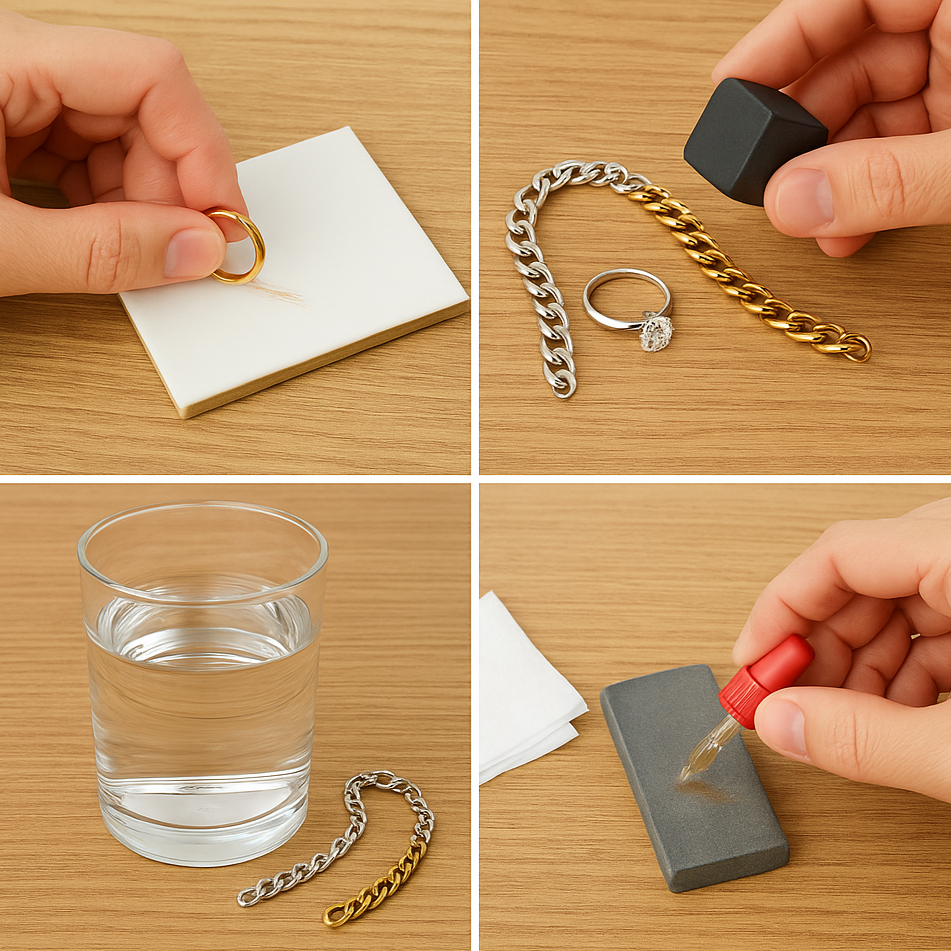
Gold or Fools' Gold? Do This at Home
How to Test Gold, Silver, and Platinum Jewelry at Home to See if It's Real
Whether you're buying vintage pieces, inheriting heirlooms, or simply curious about the authenticity of your own jewelry, knowing how to test gold, silver, and platinum at home can be both empowering and cost-saving. While professional jewelers use sophisticated tools and techniques to authenticate precious metals, there are safe and reliable methods you can use at home to get a strong indication of whether your jewelry is real or fake.
In this guide, we’ll walk you through practical, step-by-step methods to test gold, silver, and platinum jewelry from the comfort of your home. These methods include simple observation techniques, household-item tests, magnet and acid tests, and best practices to interpret results.
Why Testing Jewelry at Home Matters
Before we get into how, let's talk about why you might want to test your jewelry:
- Avoid buying counterfeit or plated pieces sold as pure precious metals.
- Determine the value of inherited or vintage pieces.
- Ensure accuracy when reselling or insuring your jewelry.
- Peace of mind, especially if you suspect you were misled.
Part 1: How to Test Gold at Home
1. Look for Hallmarks
Start with a visual inspection:
- Use a magnifying glass or jeweler’s loupe.
- Look for stamps like:
- 24K, 18K, 14K, 10K (indicates gold purity)
- 999, 750, 585, 417 (European markings)
- Also check for “GP” (gold-plated), “GF” (gold-filled), or “GE” (gold electroplated) — these indicate the piece is not solid gold.
⚠️ Note: Counterfeit items may have fake hallmarks, so use this only as an initial check.
2. The Magnet Test
Tools needed: Strong magnet (e.g., neodymium)
- Gold is not magnetic.
- If your piece is attracted to the magnet, it likely contains other metals and is not pure gold.
- However, not all non-magnetic items are real gold — some counterfeits are also non-magnetic.
✅ Result interpretation: No attraction doesn’t guarantee it's gold, but attraction definitely suggests it's fake.
3. The Float Test (Density Test)
Tools needed: Cup of water
- Drop the jewelry into a cup of water.
- Real gold is dense and will sink immediately.
- Fake or plated items may float or sink slowly.
🎯 This test is better when combined with others — it gives clues about the density but isn't conclusive on its own.
4. Skin Discoloration Test
Method:
- Rub the gold on your skin or wear it for several hours.
- Fake gold or gold-plated jewelry can cause green, black, or blue discoloration on the skin due to reaction with base metals.
- Real gold won’t discolor skin or leave residue.
⚠️ Note: This test doesn’t work well on very clean skin or if the item is mixed with non-reactive alloys.
5. The Ceramic Scratch Test
Tools needed: Unglazed ceramic plate or tile
- Lightly drag the jewelry across the tile.
- Real gold will leave a gold streak.
- Fake gold or metals will leave black or gray streaks.
⚠️ Be careful! This may scratch your jewelry.
6. Gold Testing Acid Kit
What it is: A home kit with nitric acid solutions calibrated to different gold purities.
How to use:
- Scratch the jewelry on a test stone to leave a metal streak.
- Apply a drop of acid (start with 10K and go up).
- If the streak disappears, it’s not that karat. If it remains, it matches the karat level.
🧪 This is the most accurate home test, but requires careful handling. Wear gloves and work in a ventilated area.
Part 2: How to Test Silver at Home
1. Look for Hallmarks
Typical silver hallmarks include:
- “925” (sterling silver = 92.5% pure)
- “999” (fine silver)
- “800”, “835” (coin or continental silver)
- Words like “Sterling”, “Ster”, “Silver”
Look for marks on the clasp, inside of rings, or back of pendants.
2. The Magnet Test
Silver, like gold, is not magnetic.
- If it sticks to a magnet, it’s likely not real silver.
- Some silver-plated items may have magnetic base metals.
3. The Ice Test (Conductivity)
Silver has very high thermal conductivity.
How to do it:
- Place an ice cube on the silver item.
- Real silver will cause the ice to melt quickly, even at room temperature.
🔬 This works best with thick silver pieces like bars, coins, or flatware.
4. The Tissue Test
- Rub the jewelry with white tissue or soft cloth.
- Real silver oxidizes and may leave black tarnish marks on the tissue.
- No tarnish may suggest plating or another metal.
5. The Sound Test
Tap the item with a metal object.
- Real silver produces a high-pitched, bell-like ring.
- Fake or plated silver sounds dull.
This method is often used for silver coins and larger items, not delicate jewelry.
6. Silver Testing Acid Kit
Most kits contain nitric acid for silver:
- Scratch the item on a test stone.
- Apply a drop of acid.
- If the spot turns creamy white, it’s real silver.
- If it turns green, it's a base metal or plated.
⚠️ Like gold acid kits, this test should be used carefully with proper protection.
Part 3: How to Test Platinum at Home
1. Look for Hallmarks
Common platinum stamps:
- “PT” or “PLAT”
- “950”, “900”, or “850” (indicates platinum purity)
- “IRID PLAT” (platinum alloyed with iridium)
Platinum is dense, so platinum jewelry feels heavier than it looks.
2. The Magnet Test
Platinum is not magnetic.
- If the piece is drawn to a magnet, it’s definitely not platinum.
3. Weight and Density Check
Platinum is much denser than gold or silver.
Try this:
- Compare the same-size gold and platinum rings — the platinum one will feel heavier.
- While this test isn’t precise, it can raise suspicion if the weight feels off.
4. The Scratch Test
Platinum is a hard metal but scratches more easily than gold or silver because it displaces rather than wears off.
- If your “platinum” jewelry shows unusual wear, it may not be real platinum.
5. Platinum Testing Acid Kit
Platinum acid testing solution is different from gold or silver acids.
How to test:
- Scratch the item on a test stone.
- Apply a platinum-specific acid.
- If the streak remains unaffected, it's platinum.
- If it dissolves or changes, it's not platinum.
💡 Platinum testing kits are less common but effective for serious verification.
Bonus: Tips to Avoid Damage and False Results
- Always test in an inconspicuous area to avoid visible scratches or discoloration.
- Clean your jewelry before testing to remove dirt or oils that may skew results.
- Don’t rely on one test alone. Combine visual inspection with physical and chemical tests for the most accurate conclusion.
- Be cautious with plated items, as their surface can mimic real metals but wear off over time.
When to See a Professional
While these at-home methods are helpful, they're not foolproof. Visit a professional jeweler or appraiser when:
- You’re planning to sell or insure valuable pieces.
- You want an official appraisal or certificate.
- Your at-home results are inconclusive.
Professionals use X-ray fluorescence (XRF) analyzers, specific gravity tests, and advanced acid kits that offer high-precision results without damaging your jewelry.
Final Thoughts
Testing gold, silver, and platinum jewelry at home doesn’t require expensive tools or chemistry degrees — just a little know-how and the right materials. Whether you’re curious, cautious, or collecting, these DIY methods empower you to evaluate your jewelry and make informed decisions.
Keep in mind: while home tests offer strong indications, they’re best used as preliminary assessments. For high-value items, authenticity certifications or appraisals from a trusted jeweler remain the gold standard.
Want to learn more about authenticating and valuing designer jewelry? Explore our other blog posts and guides on identifying real David Yurman and more. Whether you’re a collector or seller, knowledge is your best investment
